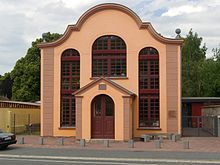Otto Stahn
Otto Stahn (born July 10, 1859 in Berlin ; † January 31, 1930 there ) was a German architect and worked as a building officer for the city of Berlin.
Life
Otto Stahn studied at the Berlin Bauakademie with Johannes Otzen . After completing his studies, he worked temporarily for the Magdeburg Railway Directorate and designed the station halls in Magdeburg , Halle and Stralsund . After a year-long stay in Italy, he was employed by the city of Berlin as a government building officer from 1888 to 1897. For the first two years in Berlin he lived at Markgrafenstrasse 16. In addition to his job with the city, Otto Stahn worked as a teacher at the royal gardening school in Berlin-Dahlem . He also appeared as a book author in the field of the “architectural garden”.
As the Berlin building officer, Otto Stahn was responsible for the artistic design of the new Berlin bridges. These include the following bridges: Luther Bridge , Moltke Bridge , Moabiter Bridge , Weidendammer Bridge and Gertrauden Bridge . He also designed the Oberbaum Bridge and the Obere Freiarchen Bridge in the Friedrichshain-Kreuzberg district . As an architect, he had to do with the elevated railway viaduct from Oberbaumbrücke to Warschauer Straße station and the high-rise buildings at Urbanhafen .

Otto Stahn realized his country house in Grunewald (1893/94) for Heinrich Müller-Breslau , the rector of the Technical University in Charlottenburg ; the picturesquely staggered, four-story plastered building is one of the oldest preserved buildings in Grunewald. His other works include various wells. The award-winning design of the technically improved municipal street pump was manufactured in cast iron by the Lauchhammer company from 1893 . Another work was the base of the Berolina on Alexanderplatz .
Otto Stahn was buried in the New Wannsee Cemetery in Lindenstrasse. The Andreas Church , which is surrounded by the cemetery, is the only sacred building that he realized (1895/96). After his teacher Johannes Otzen, also a Wannsee resident, died, the community rejected his plans and had Stahn build a newly designed church behind the already built vestibule. The hereditary funeral for Oscar Huldschinsky in the cemetery was also designed by Stahn.
literature
- Barbara Hölkemann: The Oberbaum Bridge in Berlin. Deutscher Wissenschafts-Verlag, Baden-Baden 2006, ISBN 978-3-935176-61-3 .
- Marina Wesner, Claudia M. Melisch: St. Petrikirche. A tour through the historic Cölln in Berlin. Story Verlag, Berlin 2008, ISBN 978-3-929829-87-7 , p. 52.
Web links
- Otto Stahn in the district lexicon of the Luisenstädtischer Bildungsverein
Individual evidence
- ↑ Willy Lange : Garden design of the modern age . With the assistance of Otto Stahn's architectural garden. Weber Verlag, Leipzig 1912
| personal data | |
|---|---|
| SURNAME | Stahn, Otto |
| BRIEF DESCRIPTION | German architect and municipal building officer |
| DATE OF BIRTH | July 10, 1859 |
| PLACE OF BIRTH | Berlin |
| DATE OF DEATH | January 31, 1930 |
| Place of death | Berlin |

